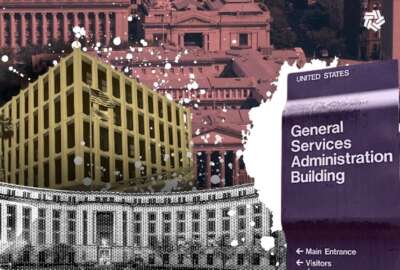GSA: ‘Right-sizing’ federal office space requires more funding on deferred upgrades
The Biden administration is facing bipartisan calls from Congress to make better use of federal office space, and get rid of buildings that agencies no longer need.
The Biden administration is facing bipartisan calls from Congress to make better use of federal office space, and get rid of buildings that agencies no longer need.
Many federal employees are preparing to head back to the office more regularly this fall, or in the coming months, after the Office of Management and Budget directed agencies to increase “meaningful” in-office work.
But the General Services Administration, the federal government’s landlord, says a lack of funds to repair or maintain government buildings is limiting the opportunities it has to sell underutilized real estate.
Nina Albert, the commissioner of GSA’s Public Buildings Service, told the Senate Environment and Public Works Committee that agencies, over nearly the past decade, missed as many as 120 opportunities to consolidate federal office space, “representing hundreds of millions in annual savings that have been missed due to lack of available funding.”
Albert told the committee on Wednesday that “right-sizing the federal footprint can be accelerated,” if GSA gains full access to the Federal Buildings Fund, where it deposits rent payments collected from agencies using GSA-owned properties.
“The opportunity before us is to transform the federal real estate portfolio into a high-performing and more efficient portfolio than today’s inventory. I like to say that we want better buildings, but fewer buildings,” Albert said.
Congress since 2011 has diverted about $1 billion each year from the Federal Buildings Fund to cover other agencies’ budgets. Albert said Congress siphoning off these funds has delayed investments in federal buildings, and limited opportunities for agencies to consolidate office space.
“We have seen minor issues grow into more costly repairs and replacements. It’s also delaying consolidation plans, forcing the government to carry space that is underutilized,” Albert said.
In the most extreme cases, delayed repairs have forced GSA to temporarily relocate a tenant agency’s employees to new space until repairs are completed.
To move ahead with consolidation, Albert said GSA needs additional funding to catch up on a backlog of deferred maintenance requests.
“Many agencies realize that they can adapt their workplaces to more effectively and cost-efficiently carry out their missions,” Albert said. “Post-pandemic, agencies are gaining additional insights about the needs of their workforce, different and better approaches to achieving their mission, as well as approaches to the workplace.”
GSA’s fiscal 2024 budget request includes $2.3 billion for capital investments in federal buildings.
Albert said GSA envisions the Federal Buildings Fund as a “quasi-resolving fund,” where the rent it collects from tenant agencies gets invested back into repairing and maintaining those buildings.
Funds from the sale of federal buildings, she added, would also go into that fund to support agency moves, consolidations and capital improvements.
The Government Accountability Office, in a recent report, found that all 24 of the agency headquarters offices it reviewed had excess space, and that 17 of them had an average occupancy rate of 25%.
Committee Chairman Tom Carper (D-Del.) urged GSA to encourage agencies to consolidate and dispose of underutilized federal office space.
“To be blunt about it, I think it’s a waste of resources,” Carper said, citing the GAO report’s findings. “It’s not a sustainable or fiscally responsible way to manage our federal real estate.”
GAO, in a follow-up report released Wednesday, found that increased telework and “longstanding challenges” have led to underutilized federal buildings.
David Marroni, acting director of GAO’s physical infrastructure team, said agencies have limited budgets to reconfigure or consolidate office space.
He told the committee that agencies still face “lingering uncertainty” about return-to-office plans, and lack reliable benchmarks for measuring building utilization that account for a higher baseline of telework since the start of the COVID-19 pandemic.
“To be clear, figuring out how much office space agencies really need and shedding any they don’t, won’t be easy, quick, or cost-free,” Marroni said.
Despite these challenges, Marroni told lawmakers that the administration should not lose sight of the “unique opportunity agencies now have to creatively and fundamentally reconsider their office space needs.”
“Agencies need to ask themselves, ‘Are there ways to reduce our footprint and save money, while still ending up with more modern space that helps us better accomplish our mission?’” he said.
The federal government’s real estate portfolio has been on GAO’s High-Risk List since 2003, mostly because the government has more space than it needs, Marroni said.
OMB across multiple administrations has launched efforts to freeze and reduce the federal real estate footprint.
Albert said the federal government, over the past 10 years, has reduced its real estate portfolio by 45 million square feet.
The federal government, according to GAO, still owns 511 million square feet of office space, which costs billions of dollars every year to maintain.
GAO in its latest report found federal agencies spend about $2 billion a year to operate and maintain federal office buildings regardless of the buildings’ utilization. They also spend about $5 billion annually to lease office buildings.
GAO states that before the pandemic, federal agencies still struggled to figure out how much office space they needed.
“As the country emerges from the pandemic and agencies continue to offer telework as an option, the federal government has a unique opportunity to reconsider how much and what type of office space it needs,” GAO wrote.
In June, GSA announced its plan to spend $1 billion from the Inflation Reduction Act on making 100 federal buildings more sustainable and energy efficient.
Albert said those IRA projects are taking place at “core assets” the federal government plans to keep long-term, and are in need of revitalization.
Beyond GSA’s portfolio of buildings it owns, Albert said the agency is also working with agencies to reduce leased office space. More than half of GSA’s leases are set to expire by 2027.
Albert said that GSA starts working with agencies about two years out from when their leases are set to expire. As part of these talks, GSA asks agencies about their future office space needs, as well as opportunities to consolidate and save money.
“What we are finding now is the agencies are looking at their building capacity and identifying lease expirations in this region and when appropriate, trying to pull those leases into federally owned properties,” she said.
She added that, over the past three years, agencies that had expiring leases reduced their leased space anywhere from 25% to 40%.
Over the last five years, GSA saved about $6 billion by eliminating unneeded leased space.
“That is a tremendous track record that we absolutely will build on going forward,” Albert said.
Copyright © 2025 Federal News Network. All rights reserved. This website is not intended for users located within the European Economic Area.
Jory Heckman is a reporter at Federal News Network covering U.S. Postal Service, IRS, big data and technology issues.
Follow @jheckmanWFED





